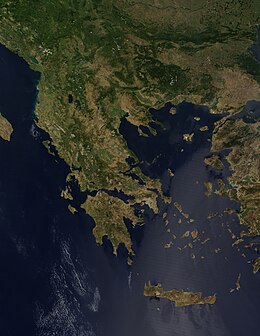
Back جغرافيا اليونان Arabic Xeografía de Grecia AST Yunanıstan coğrafiyası Azerbaijani Геаграфія Грэцыі Byelorussian Геаграфія Грэцыі BE-X-OLD География на Гърция Bulgarian গ্রিসের ভূগোল Bengali/Bangla Geografia de Grècia Catalan Geografie Řecka Czech Daearyddiaeth Gwlad Groeg Welsh
This article includes a list of general references, but it lacks sufficient corresponding inline citations. (February 2023) |
 | |
| Continent | Europe |
|---|---|
| Region | South Europe |
| Coordinates | 39°00′N 22°00′E / 39.000°N 22.000°E |
| Area | Ranked 95th |
| • Total | 131,957 km2 (50,949 sq mi) |
| • Land | 99.13% |
| • Water | 0.87% |
| Coastline | 13,676 km (8,498 mi) |
| Borders | 689.76 km (428.60 mi) |
| Highest point | Mount Olympus 2,918 metres (9,573 ft) |
| Lowest point | Epitalio −6 metres (−20 ft)[1][2] |
| Longest river | Haliacmon 297 kilometres (185 mi) |
| Largest lake | Lake Trichonida 98.6 km2 (38.07 sq mi) |
| Terrain | 80% mountainous, plains (east and north-east) |
| Natural resources | petroleum, magnetite, lignite, bauxite, hydropower, marble, limestone, fish[3] |
| Natural hazards | earthquakes, floods, droughts and wildfires |
| Environmental issues | air pollution, water pollution |
| Exclusive economic zone | 505,572 km2 (195,202 sq mi)[4] |
Greece is a country in Southeastern Europe, on the Balkan Peninsula.[5] It is bordered to the north by Albania, North Macedonia and Bulgaria; to the east by Turkey, and is surrounded to the east by the Aegean Sea, to the south by the Cretan and the Libyan seas, and to the west by the Ionian Sea which separates Greece from Italy.
The country consists of a mountainous, peninsular mainland jutting out into the Mediterranean Sea at the southernmost tip of the Balkans, and two smaller peninsulas projecting from it: the Chalkidiki and the Peloponnese, which is joined to the mainland by the Isthmus of Corinth. Greece also has many islands, of various sizes, the largest being Crete, Euboea, Lesvos, Rhodes, Chios, Kefalonia, and Corfu; groups of smaller islands include the Dodecanese and the Cyclades. According to the CIA World Factbook, Greece has 13,676 kilometres (8,498 mi) of coastline, the largest in the Mediterranean Basin.[6]
Greece's latitude ranges from 35°N to 42°N and its longitude from 19°E to 28°E. As a result of this and its physical geography, the country has considerable climatic variation.
- ^ "Greece topographic map". Retrieved 16 February 2023.
- ^ Cite error: The named reference
meteoclub1was invoked but never defined (see the help page). - ^ Cite error: The named reference
greeka1was invoked but never defined (see the help page). - ^ Cite error: The named reference
searounduswas invoked but never defined (see the help page). - ^ "UNITED NATIONS GROUP OF EXPERTS ON GEOGRAPHICAL NAMES: Working Paper No. 48" (PDF). UN. 2006. Retrieved 2 September 2015.
- ^ Cite error: The named reference
CIAwas invoked but never defined (see the help page).
© MMXXIII Rich X Search. We shall prevail. All rights reserved. Rich X Search